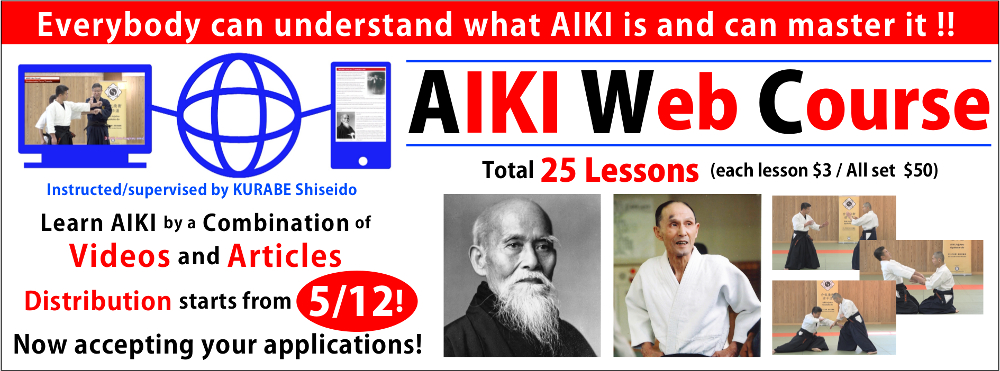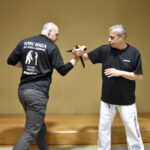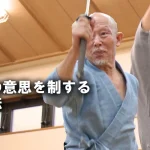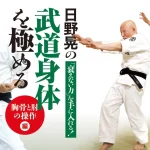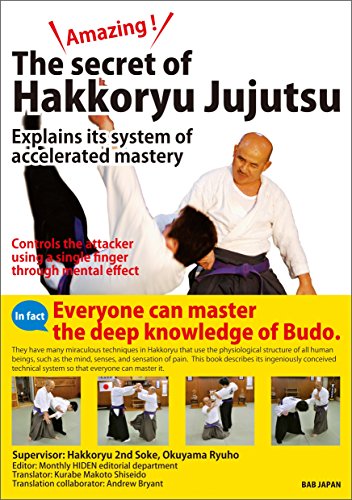 This book discloses the secrets of Hakkoryu Ju- jutsu, which influenced the development of many other Budo Ryuha
This book discloses the secrets of Hakkoryu Ju- jutsu, which influenced the development of many other Budo Ryuha
Hakkoryu techniques do not depend on muscular power. By using its sophisticated techniques, one can control another instanta- neously, even without clearly visible movement. Although the name Hakkoryu is very famous among many martial artists, its secrets have never been disclosed to the public until now.
At long last, a book has finally been published that reveals its secrets. Many martial artists all over the world have been waiting years for this book.
They have many miraculous techniques in Hakkoryu that use the physiological structure of all human beings, such as the mind, senses, and sensation of pain. This book describes its ingeniously conceived technical system so that everyone can master it.
You can buy this book on Amazon.com!
We introduce begining of this book in 3 parts!
Amazing ! The Secret of HAKKORYU JUJUTSU
Explains its system of accelerated mastery
Supervisor: Hakkoryu 2nd Soke, Okuyama Ryuho
Editor: Monthly HIDEN editorial department
Translator: Kurabe Makoto Shiseido
Translation collaborator: Andrew Bryant
Preface
By Hakkoryu 2nd Soke, Okuyama Ryuho
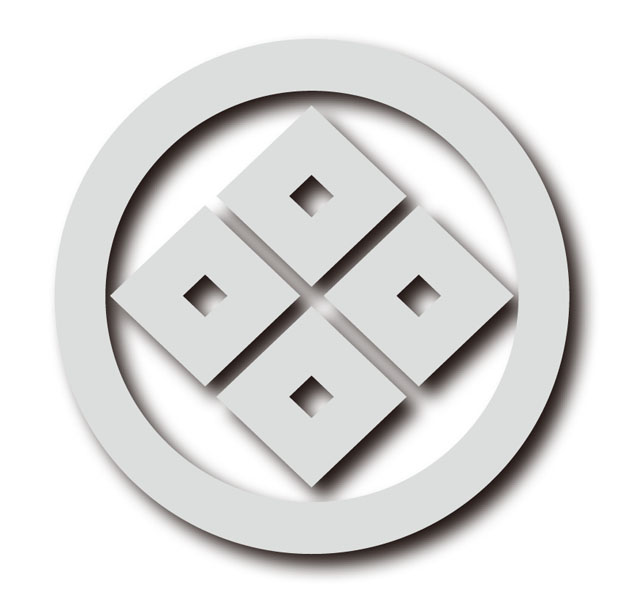 Between 2008 and 2014, a series of articles were published in the Japanese martial arts journal Hiden, which introduced our Hakkoryu Jujutsu to its readers. Because the editors of Hiden had received a lot of impressive reaction from the readers they decided to publish these articles as a book. In this way they published this book, which consists of the essence of that series of articles that described Hakkoryu Jujutsu.
Between 2008 and 2014, a series of articles were published in the Japanese martial arts journal Hiden, which introduced our Hakkoryu Jujutsu to its readers. Because the editors of Hiden had received a lot of impressive reaction from the readers they decided to publish these articles as a book. In this way they published this book, which consists of the essence of that series of articles that described Hakkoryu Jujutsu.
Our Hakkoryu has the formal name of Nippon Bugei Tsukasa Goshindo Hakkoryu Jujutsu (日本武芸司護身道八光流柔術) which translates as “Japanese traditional self-defense martial art of the Eighth-Lights System”.
In the past, before the Second World War (WWII), our dojo (named 八光流講武塾Hokkoryu Koubu Juku) was located at the Kanda Otamagaike (神田お玉が池), area of Tokyo. This place is quite famous among bujutsu enthusiasts because the Genbukan Dojo (玄武館道場) of the famous Hokushin Itto-ryu school of Kenjutsu (北辰一刀流剣術) was located there at the end of the Tokugawa Shogunate (1603 to 1868). That dojo was crowded, with a lot of visitors who wished to receive our founder’s instruction. Almost every day the dojo was filled with around 150 people who came, not only from Japan, but from other Asian countries. The training was done one-on-one, through private instruction with the founder. Because it was on a “first come, first served” basis, every day visitors waited in a long line in front of the dojo building.
The founder, 1st Soke Okuyama Ryuho, taught his students using this one-on-one teaching method, which utilizes every minute for the direct transfer of knowledge from teacher to student. He never wasted time in vain, like instructing, then waiting, or pausing as students practiced, which was done in most of other schools at that time. During class time, he tried all his best to teach his students “how to save oneself from potential danger”. This could be the reason why he attracted so many people wishing to learn our Hakkoryu.
It is a remarkable feature of Hakkoryu that people can practice the entire curriculum, even in such a small area as 2. Accordingly, everyone can practice Hakkoryu anytime, anywhere, as our founder instructed. And in this way people can regard Hakkoryu as a Bujutsu on which people can dedicate their highest effort to master.
I often receive reports from my students who had occasion to defend himself/herself against violence thanks to Hakkoryu’s techniques, through which one can control the attacker, even using a single finger. Because our Hakkoryu does not specialize in brutal techniques such as striking and kicking, but rather, offers a more sophisticated system, a lot of people are attracted to it as a modern method of self-defense to be used as a means of physical and mental training.
When a person masters Hakkoryu he/she should notice the effect that an aggressive heart will become more peaceful, a timid heart will become braver, and thick-headed person can become a wiser person. Also, an indecisive person can learn to make a more decisive decision, and a lethargic person can become quite energetic, thanks to the result of training diligently in Hakkoryu.
In Hakkoryu, we reject all types of fighting methods that use any type of weapon, and we teach people how to defend themselves against violence by cultivating minds and moral character, through the course of mastering this system. In fact, once one starts learning Hakkoryu, he/she should begin improving his/her physical appearance from the effect of changing on the inside (the mind).
Here, I write the message that our founder sent to all the people who attempt to master Hakkoryu.
“If our Hakkoryu can help those people who try to establish a resolute and stable personality, filled with hopes and ideals, I feel happiest. If you are a person who cannot pretend to not see the actual world, with a lot of wickedness, come and join us. Hakkoryu shall guide you to a place where you feel “you do not need to search, but you earn what is valuable to you for yourself.”
Chapter 1
To raise your hand as if to scratch your itchy ear
“In case the opponent grasps your right wrist by his left hand, you should focus your target when applying Waza onto his right foot.”
In Hakkoryu there is a principle that a weak point appears where the tension occurs due to the person’s putting or concentrating his force there when he tries to attack the other. And accordingly Okuyama 2nd Soke pointed out the right foot should be the place where the attacker concentrates his force in that case. But why the right foot?
“A human body does not always act as one expects” Okuyama 2nd Soke said, and grinned.
After watching his performance I could understand what he said. When I considered it the first time, I guessed the place where one concentrates force should depend on the posturing of the attacker. But after watching the actual attacking action several times I could recognize that the attacker concentrated some force onto his right foot every time.
I guess he unconsciously positioned his body on his right foot when he tried to attack by grasping 2nd Soke’s right wrist with his left hand. The person who took the attacker’s role never expected it and he was very surprised when this was pointed out by Okuyama 2nd Soke.
Okuyama 2nd Soke continued, “We call this phenomenon as a form of mental effect. The founder discovered how to make the most of this mental effect using Jujutsu techniques and Hakkoryu Jujutsu was founded based on that concept.”
I made my goal writing this book to elucidate or disclose the secret of Hakkoryu, with the key point of this mental effect. But this mental effect itself is invisible, as such I need Okuyama 2nd Soke’s detailed explanation from the very basic point or I could never understand this concept. Now let’s start from the beginners’ level.
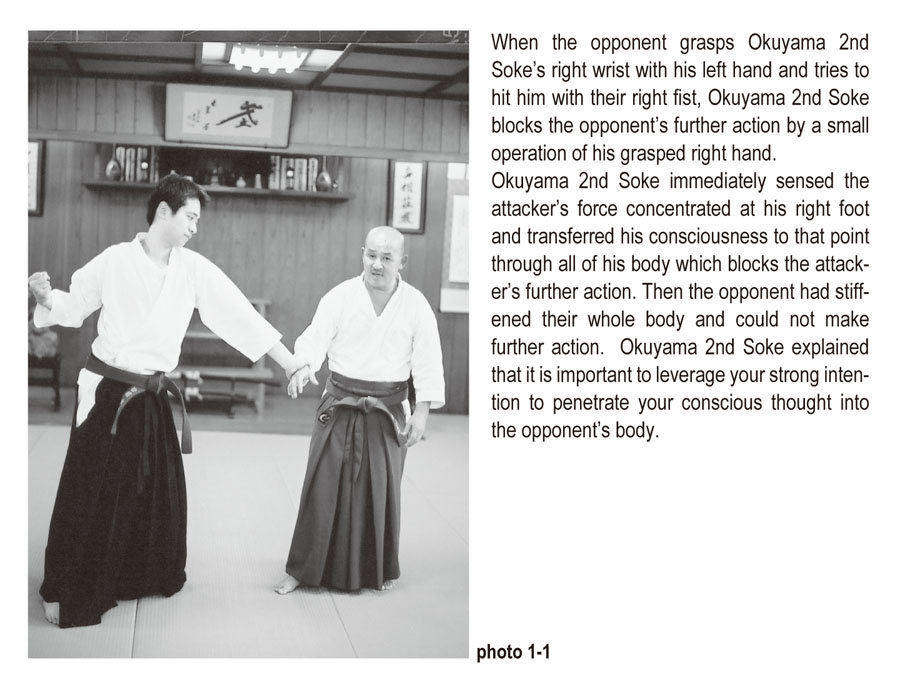
◎Scratch your itchy ear:
Here again the consequence of Hakko Dori is shown with [photos 1-2]. At a glance it looks like a simple “releasing action of the grasped wrist”. For this technique the action shown in the first 3 photos is the most important part. Unless you have never tried this yourself, you will never notice how difficult this technique is.
The action itself is quite unique, it translates to 8 movement toward the light. I suppose many of the readers might have received instruction as “If you place your arms tightly to the side of your body, then you can raise your arms.” In this way one can surely create stronger physical power in their arms which helps to raise them. But in Hakkoryu, the correct way is based on a totally different theory applications.
“In case the opponent grasps your wrist with much stronger power than you expect, you unconsciously put your attention onto the muscle of the grasped arm. Accordingly you start trying to raise your arm with force and it does not work.
In such a case you should not put your conscious thought onto the muscle of the arm, nor onto the grasped wrist. You should wholly forget that your arm is grasped.”
Although I received such instruction from Okuyama 2nd Soke, I cannot help thinking that it is still the arm’s muscle which raises arm, which could already be a bad start in attempting to use this mental effect.
Then he advised me again as below.
“If you try to raise your arm using muscle, it becomes a competition of your power and the opponent’s power. We should strictly avoid such situations in Hakkoryu. At first you should wholly relax yourself. Then you should create force from the Tanden (abdomen) but not from the arm.”
After hearing this advice to “create force from the Tanden but not from the arm” I started feeling I could relax myself without putting force in my arm. Then forces in my body started to organize the correct correlated motion, although there should not be any special organization in my Tanden which can create force alone. Perhaps we human beings have such a mechanism that we can create force from the entire body if we become conscious to our Tanden. This also could be a kind of mental effect.
Not only in Jujutsu but also in many other Bujutsu, people place significant importance on how to leverage this organized power of the Tanden. So I noticed its importance once again. But on the other hand, I still cannot help but use the biceps muscle in my upper arm to raise my arm. But Okuyama 2nd Soke’s one short instruction had solved my confusion immediately.
“Raise your arm as if you are scratching your itchy ear”
So I tried exactly as he advised me. I imagined my ear was itchy and tried to scratch that ear with my grasped hand. Then what a big surprise it was! I could raise my grasped arm easily.
Okuyama 2nd Soke explained to me further.
“People might think there exists many different and correct ways to carry out one thing. But the best way is always a single way and not several. You only have to find it and do it. Please imagine when you scratch your itchy ear, you never intentionally try to find the way to move your arm or which muscle you should use.”
Hearing his additional explanation, I surely agree with what he says.
“Wow, it is so simple!” I immediately understood it, but then I thought about it differently, i.e. I tried to raise my arm by putting my conscious thought onto the wrong point. Accordingly I tried to raise my arm in a wrong way.
When one tries to carry out one thing and he encounters even a tiny degree of resistance, he might fall into such a situation that he starts to resort to inappropriate reactions.
Okuyama 2nd Soke continued his explanation.
“Mental effect happens instantaneously and accordingly, unconsciously. That is why it might cause inappropriate reactions. It might happen in such a case that you cannot raise your arm because the opponent grasps your wrist with stronger force than your expectation. At the instant you feel it, you start thinking you have to create stronger force in your arm. Such simple thinking of comparing force triggers putting force into the muscles of your arm. Then you stop thinking over the other possibilities and that idea leads you to the worst scenario. You should imagine that your arm was free from the grasp and you could move it freely. I advise you to try to move your hand/arm as if you are scratching your itchy ear using that hand. This means you move your arm as if your arm was free.”
In most Bujutsu and competition sports, people try their best to attain the strength by which they can overcome their opponent and/or target. I believe they put their greatest effort to attain that goal. On the contrary, we aim for a totally different goal in Hakkoryu. Generally speaking, in Bujutsu one can never compete with the same opponent twice. The competition would be just once which results in winning (live) or losing (death) and the competition with the same opponent can never occur again. Accordingly if you lost a single match, there is no next chance for you to prepare and improve.
Then what should you do in Bujutsu?
You only have to take the most appropriate motion in a natural way. The problem often occurs in the moment you get the idea that you still have a chance for a rematch if you cannot win this time. It happens instantaneously and unconsciously.
Besides, one tends to consider that it is a natural reaction for one to think over the rematch in the case of losing that first match and it causes the biggest problem.
“If you fail to raise your arm, then you try to increase your force.” You should notice that this is the wrong way of thinking from the start.
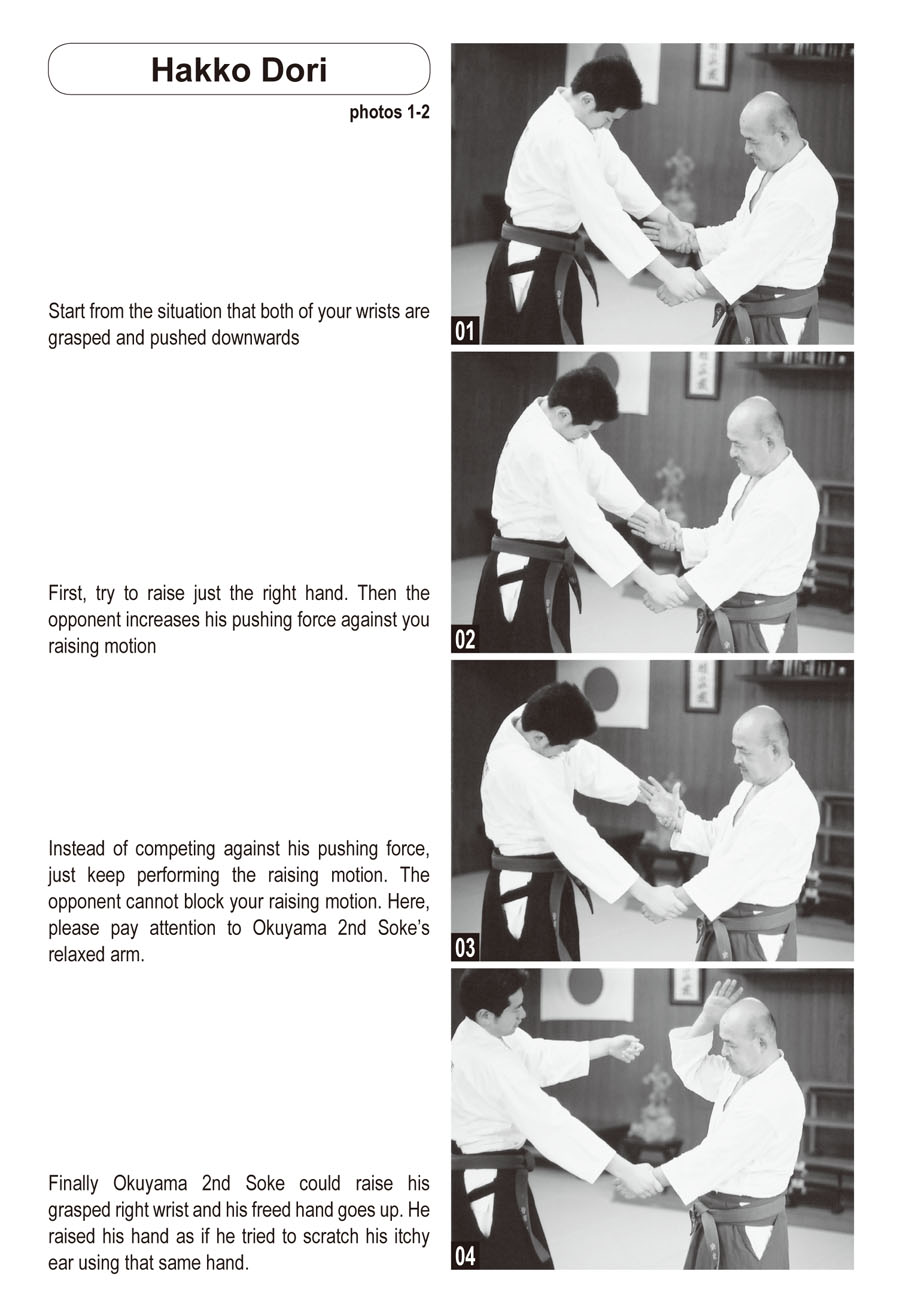
◎Hakkoryu’s three main principles: no challenge, no resistance and no injury
”When I receive a guest for their first trial class at our Dojo, I can immediately distinguish the person’s intention when I let him perform Hakko Dori and he grasps my wrists. His intention can be to compete with me or to learn from me, or both, which means he has not decided yet. I often encounter such situations, especially abroad where there are so many men with strong muscles who try to challenge and defeat me by creating a situation in which I cannot raise my hand in Hakko Dori. In such a situation I should never try to compete with them using power. If I do so I cannot raise my grasped arms. It is our principle that you become weaker as you try to compete with the opponent by increasing your power.”
In Hakkoryu they put their highest value on the obedient personality of the Deshi (student). In other words, they have the three main principles: no challenge, no resistance and no injury. These three restrictions explain how we should deal with mental effect which is caused automatically and instantaneously in many cases. Unnecessary reactions such as intimidation, bravado, bullying, weakness, and so on are caused in the certain cases. I might suggest that those negative elements which lead a person to failure, not only in Bujutsu, but also in everyday life are caused by this mental effect.
When you are faced with a difficult task, you probably carry it out by forgetting all those negative mental attitudes and just simply do it, like raising your arm just simply to scratch your itchy ear.
This is Hakkoryu’s concept, how to deal with mental effect teaches us how we should behave in the difficult situations. That concept teaches us to never worry, which is not necessary at all.
“It could be difficult to realize that concept. But I can explain to you in easier words, such as “Change your mind and never stick to one idea”. Anyway it is important not to think it over too much.”
Okuyama 2nd Soke gave this further advice to me and laughed loudly.
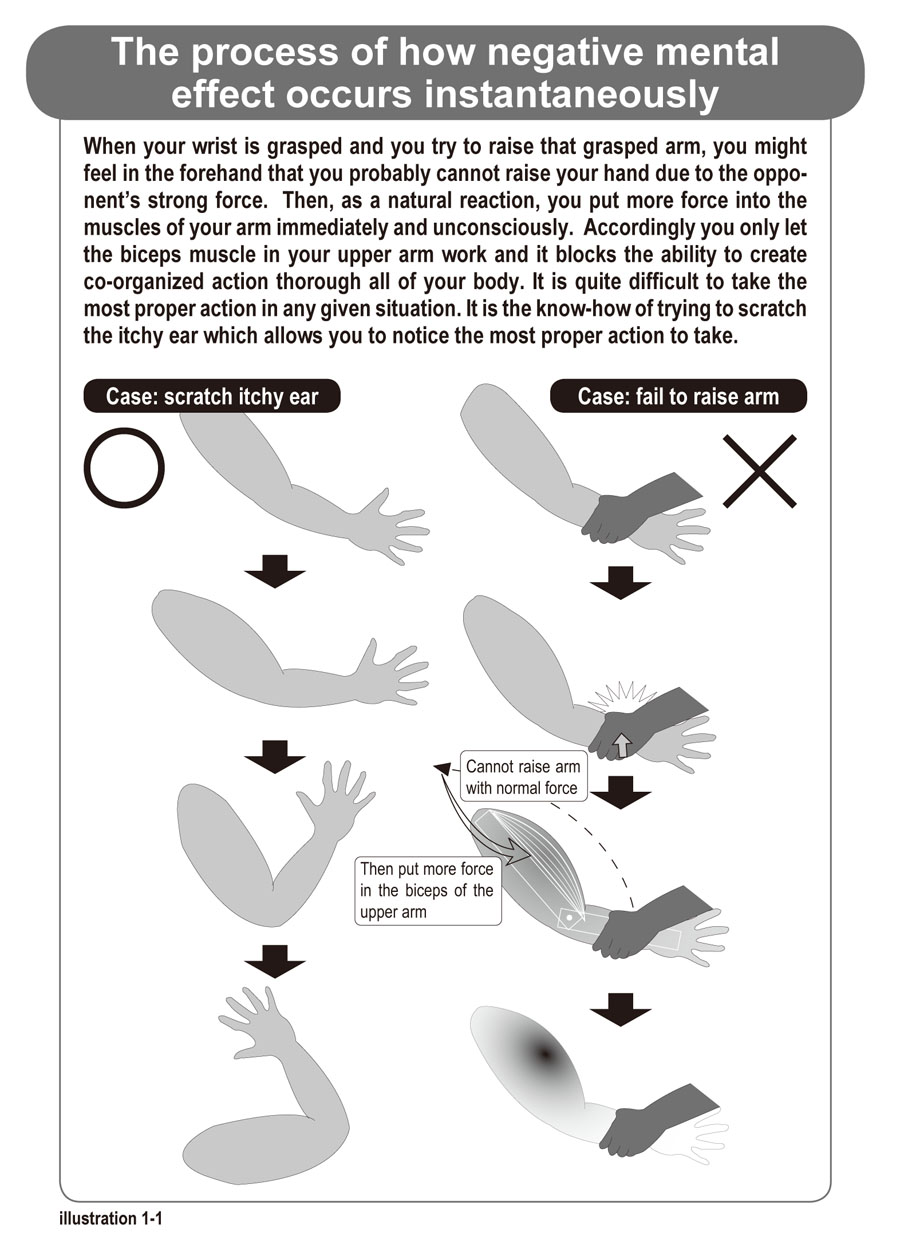
 Hearing his additional advice above, I started accepting his idea and I started wishing I could do so. I also started laughing together with Okuyama 2nd Soke.
Hearing his additional advice above, I started accepting his idea and I started wishing I could do so. I also started laughing together with Okuyama 2nd Soke.
I must confess that I am the type of person who is often lost in thought, but at that moment, I could accept his concept quite naturally and easily. It was the instant that I could feel myself a little more grown up.
I started writing this book with a subject of mental effect which has an enormous amount of related topics and subject matters. Those will be explained in greater detail later. By the way, it is just one of the examples of how to explain the huge related subjects that the founder wrote a book titled “analogical hitting mark method” which could be applied to gambling such as horse racing.
At the starting of AIKI Web Course
Cooperating with BAB Japan Co., Ltd., hereby I start AIKI Web Course in order to realize my long-standing desire to let as many as martial arts fans all over the world have the correct knowledge of AIKI and learn how to practice AIKI.
This course consists of
Part 1 as introductory articles, I explain a wide range of knowledge about what AIKI is, which contains 6 lessons.
Part 2 as main articles, for beginners/intermediate level, I explain how to practice AIKI to master. It contains 24 lessons.
The each lessons will be uploaded on BudoJapan website one by one every week.
I hope as many people as possible will be interested in AIKI and become able to practice it by following this course.
AIKI Web Course 25 Lessons
-
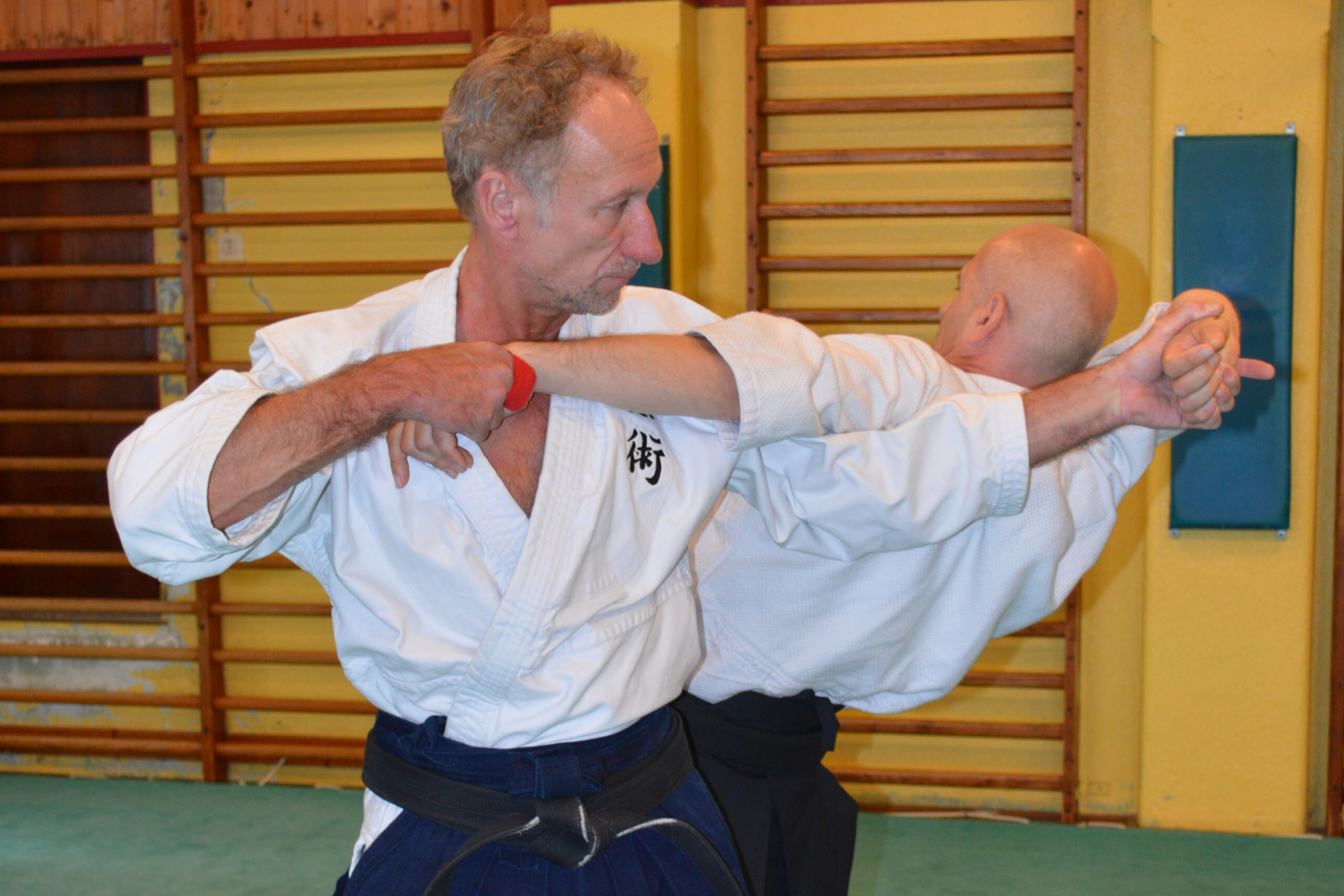
【AIKI JUJUTSU GYAKUTE-DO Series No.5】How you can learn Jujutsu properly
-
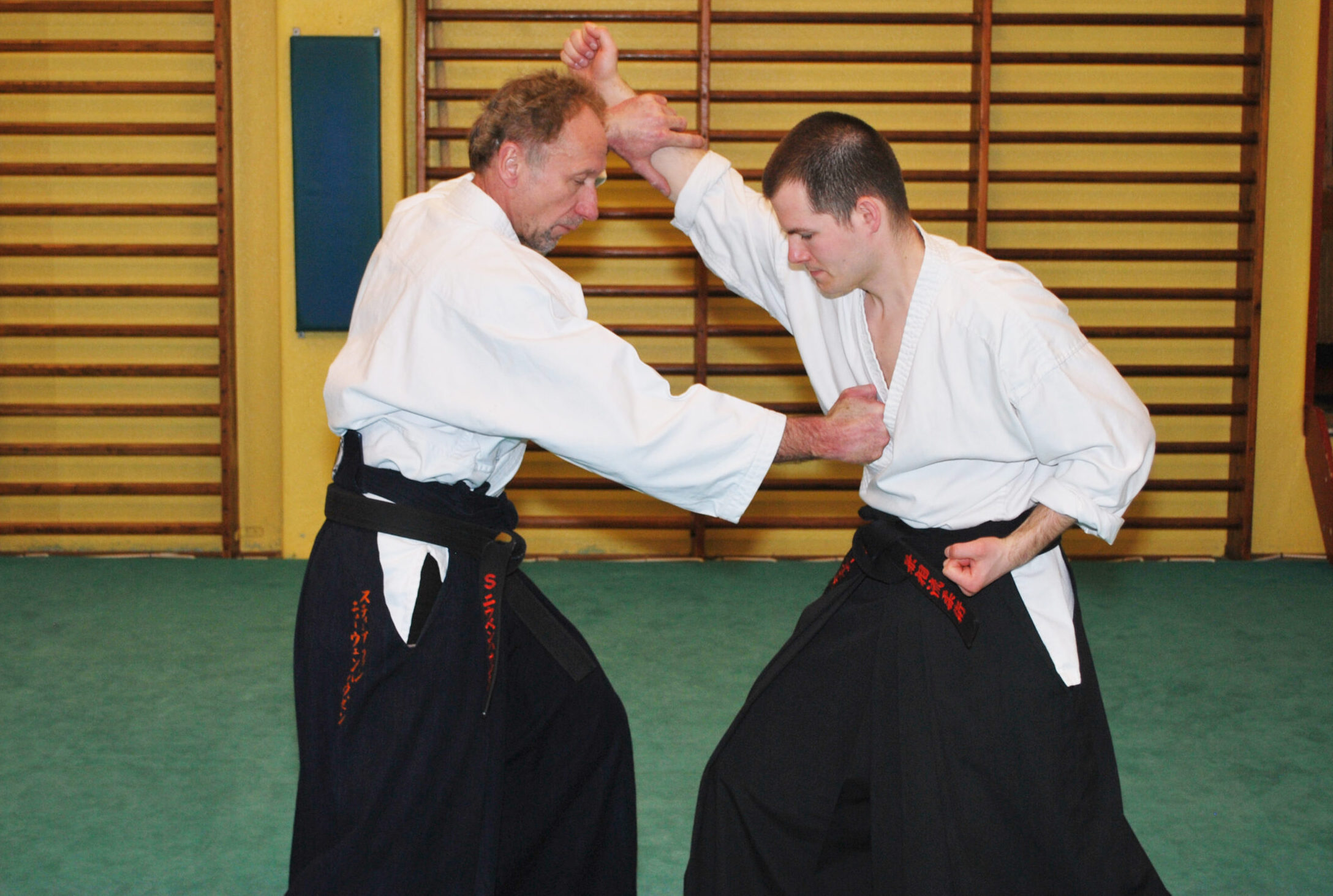
【AIKI JUJUTSU GYAKUTE-DO Series No.4】DAKEN-HO Hit and Kick KATA and AIKI
-
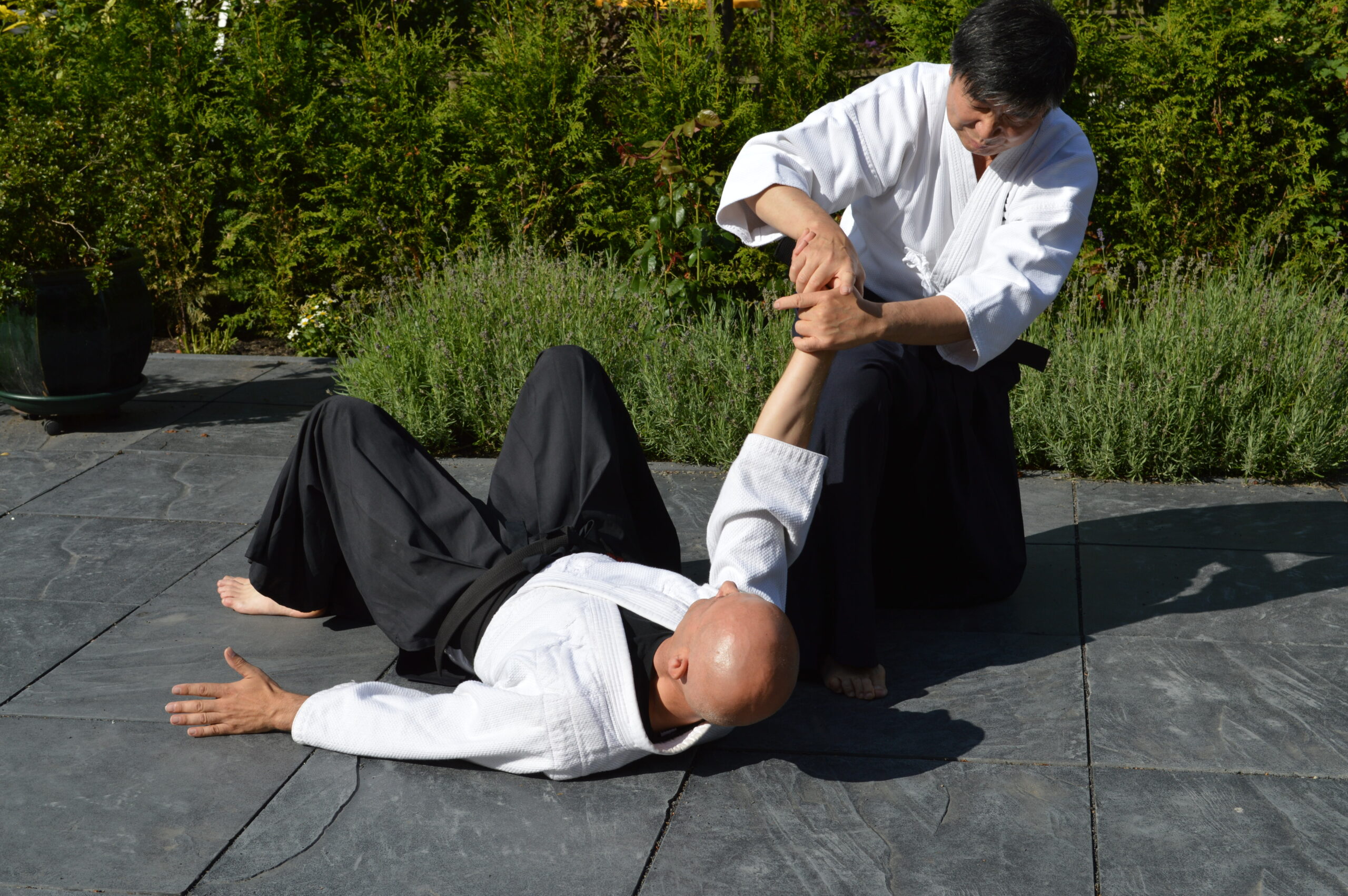
【AIKI JUJUTSU GYAKUTE-DO Series No.3】JUJUTSU WAZA, digest of FUDO
-
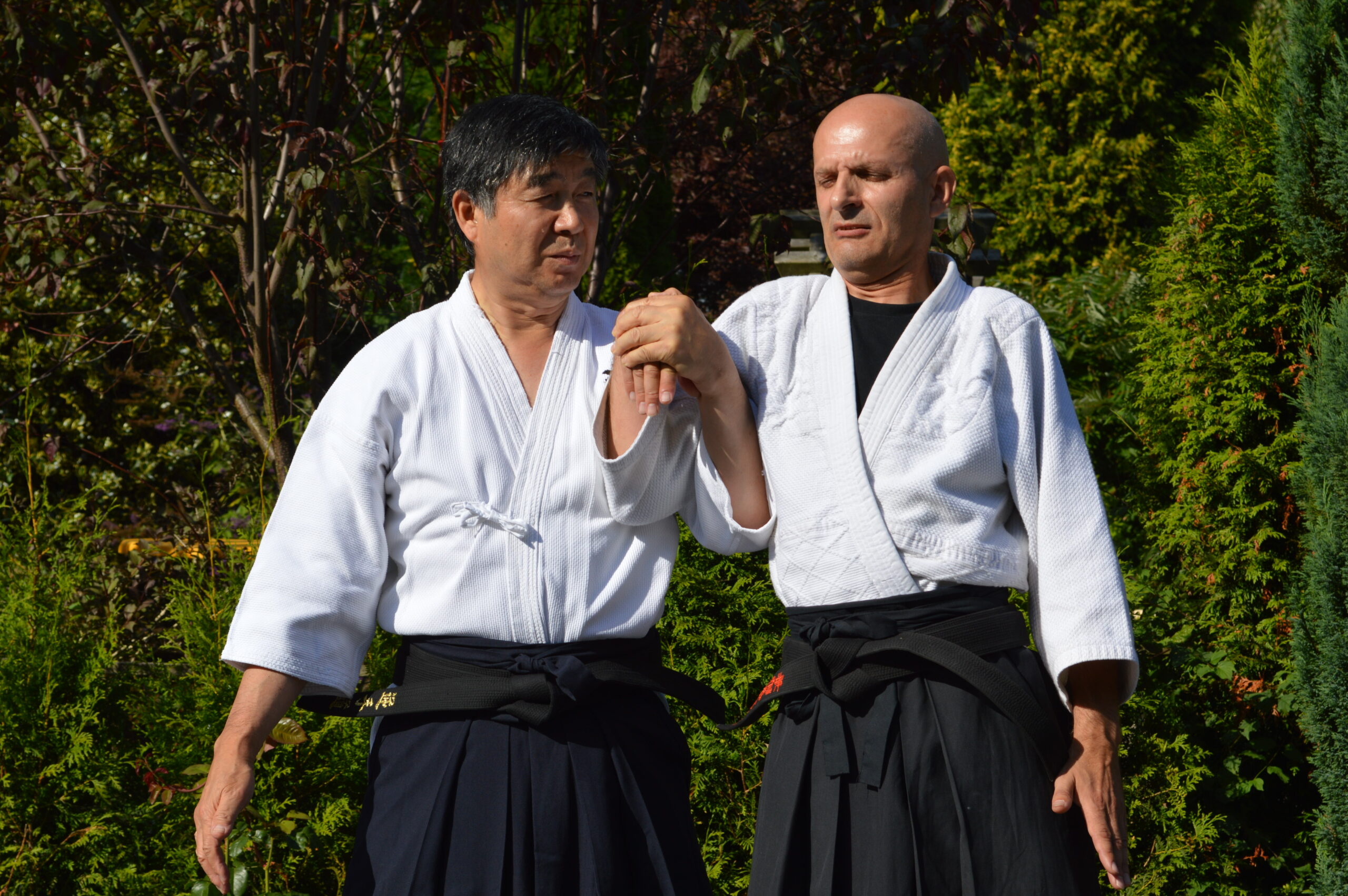
【AIKI JUJUTSU GYAKUTE-DO Series No.2】JUJUTSU WAZA, digest of NUKI, RENKO and NAGE
-

【AIKI JUJUTSU GYAKUTE-DO Series No.1】About GYAKUTE-DO and the digest of its basic techniques
-
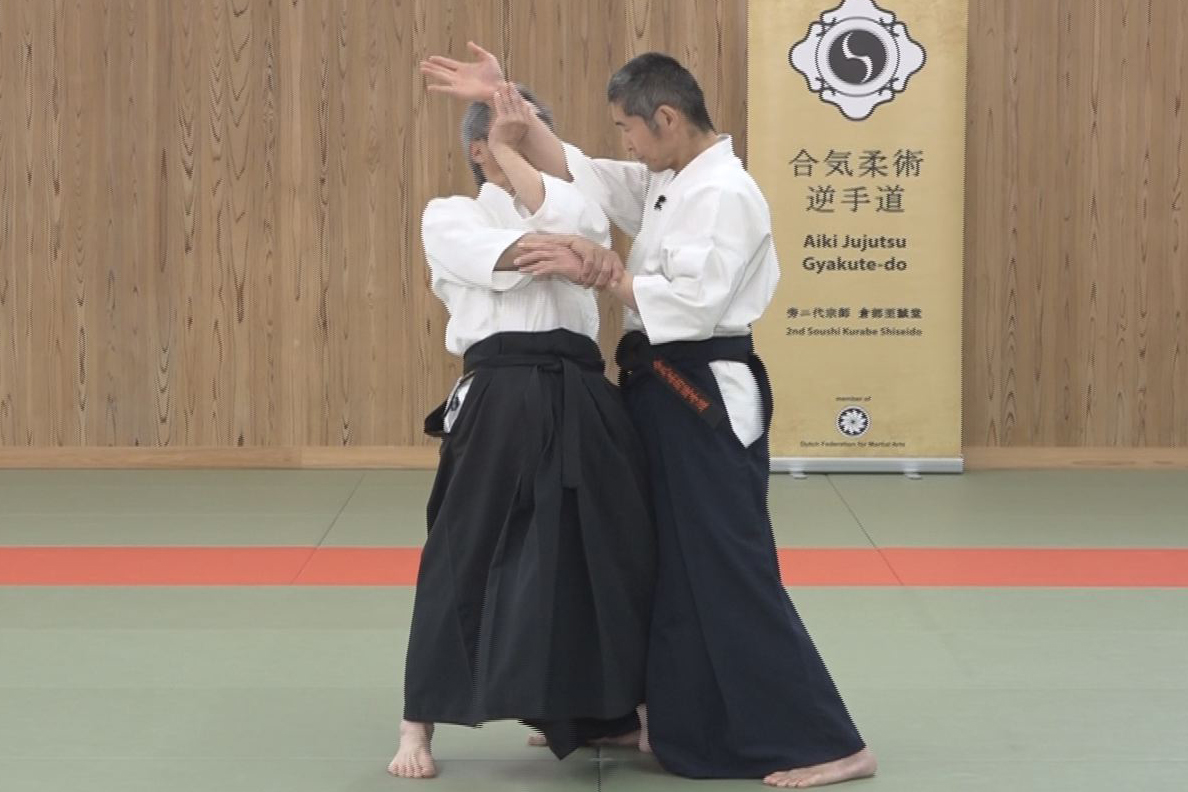
【AIKI Web Course Part 2】Lesson 24 With Comb. of Different Methods #2
-
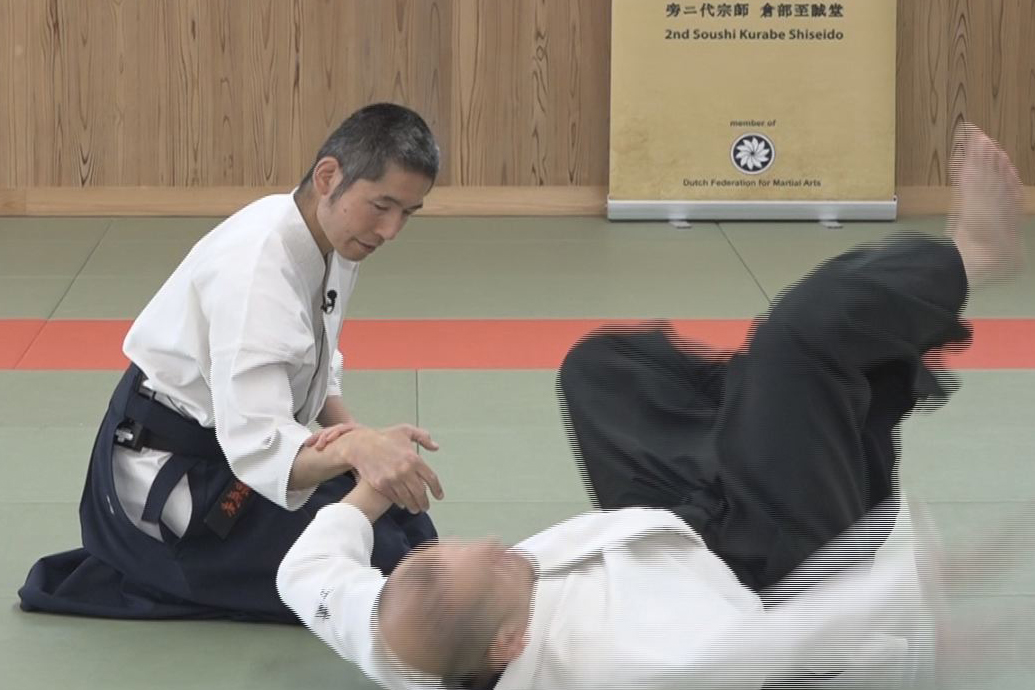
【AIKI Web Course Part 2】Lesson 23 With Comb. of Different Methods #1
-

【AIKI Web Course Part 2】Lesson 22 Advanced Tech. using F. E. method #2
-

【AIKI Web Course Part 2】Lesson 21 Advanced Tech. using F. E. method #1
-

【AIKI Web Course Part 2】Lesson 20 Advanced tech. using T. F. T. #2
-
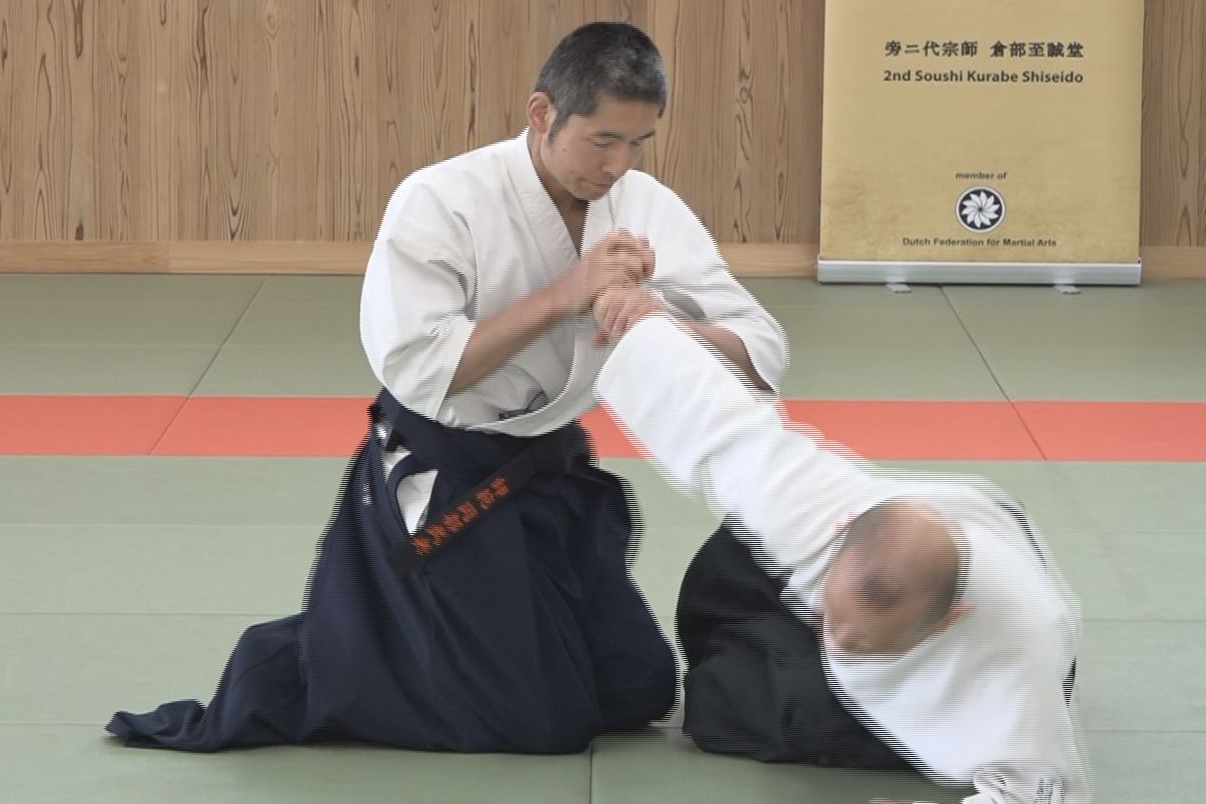
【AIKI Web Course Part 2】Lesson 19 Advanced tech. using T. F. T. #1
-
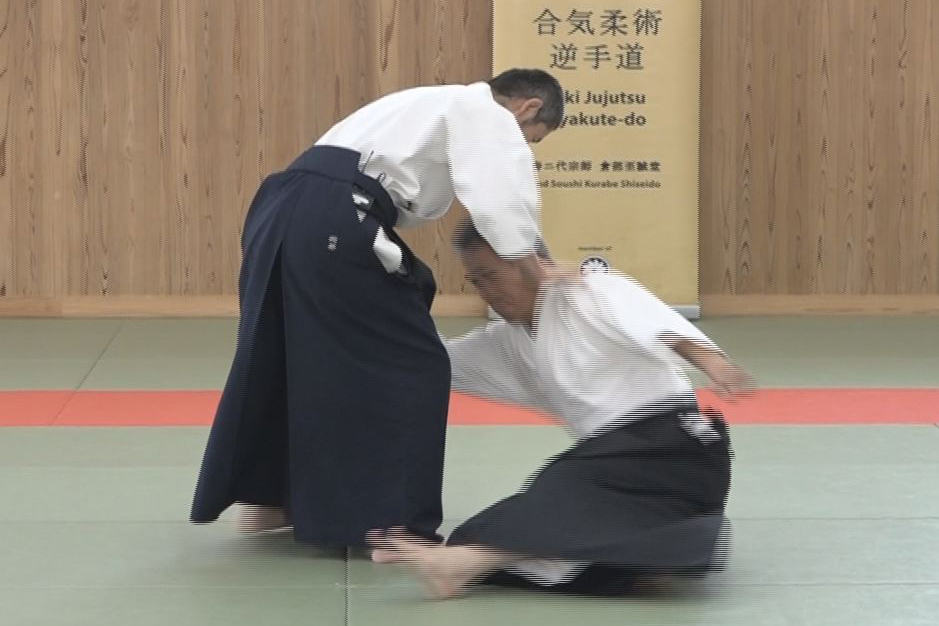
【AIKI Web Course Part 2】Lesson 18 Advanced tech. using AIKI Contact #2
-
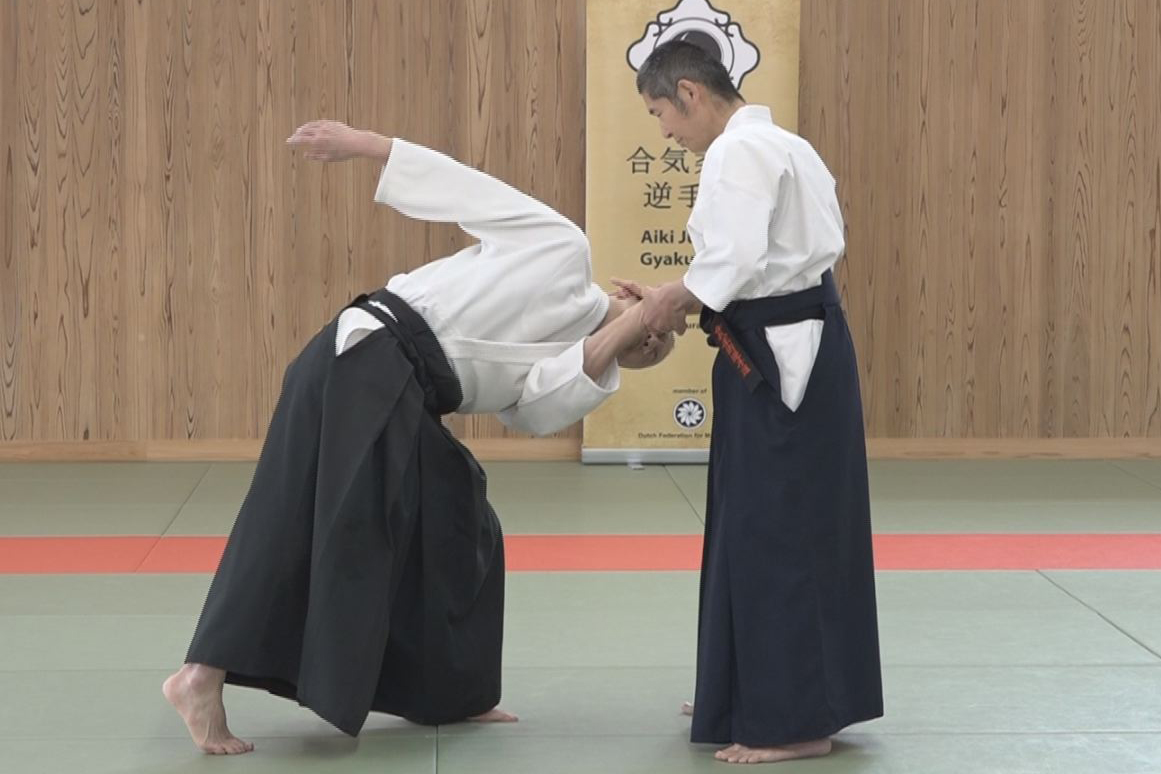
【AIKI Web Course Part 2】Lesson 17 Advanced tech. using AIKI Contact #1
-
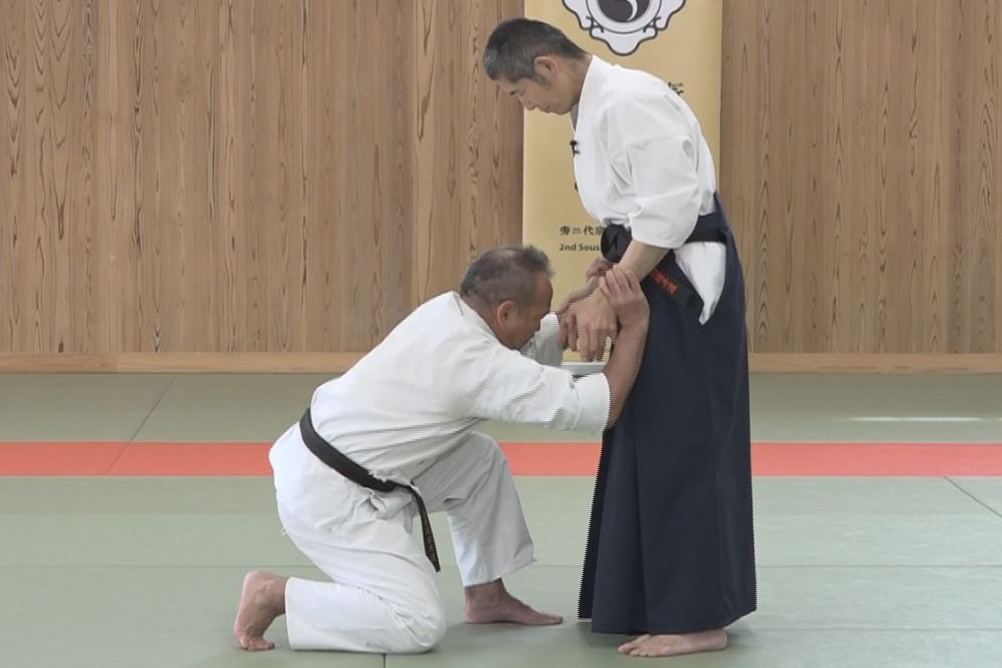
【AIKI Web Course Part 2】Lesson 16 Advanced tech. by Undetectable F.T. #2
-
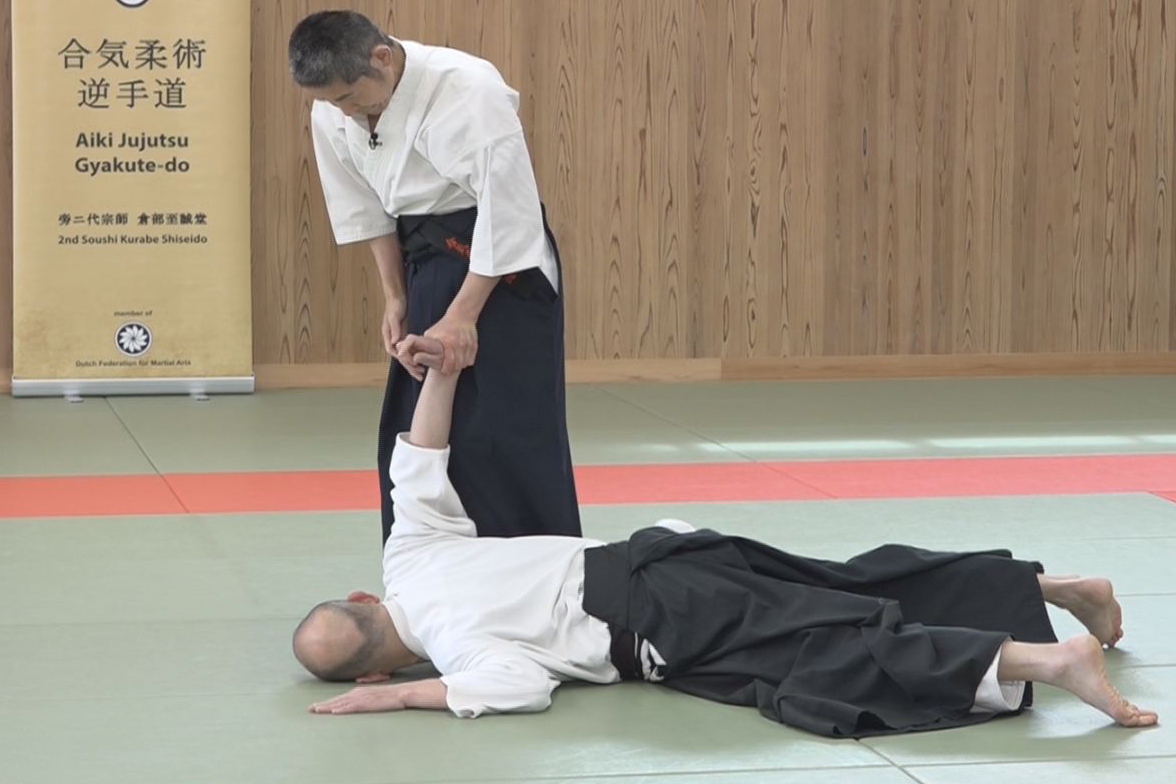
【AIKI Web Course Part 2】Lesson 15 – Advanced tech. by Undetectable F. T. #1
-

【AIKI Web Course Part 2】Lesson 14 – Advanced tech. by the Waving method #2
-
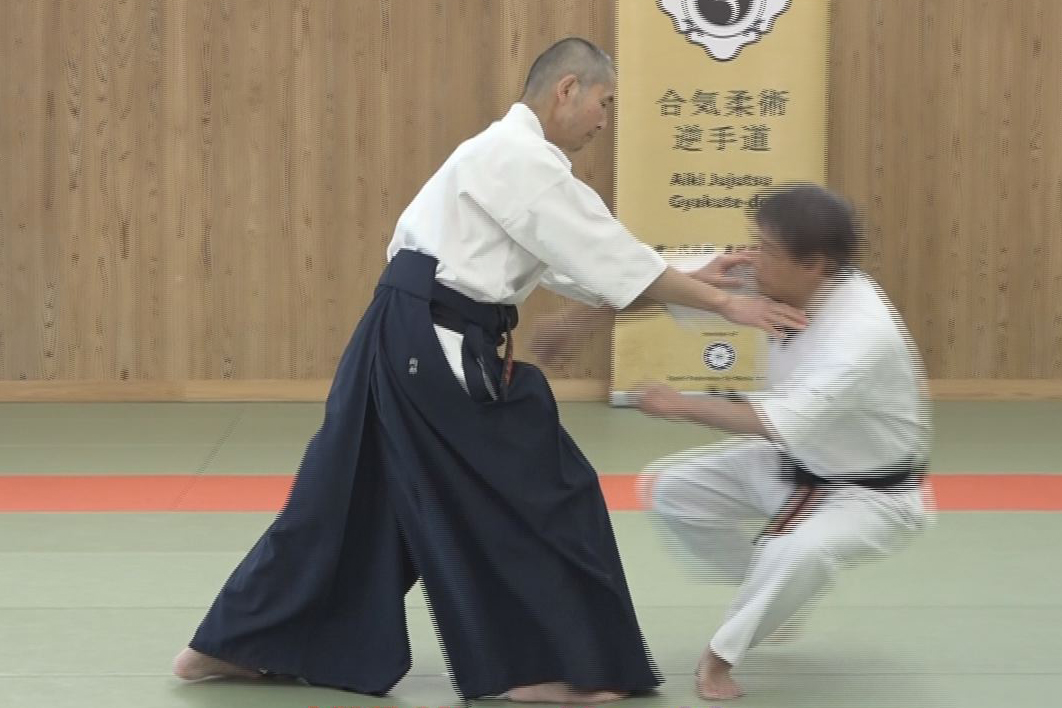
【AIKI Web Course Part 2】Lesson 13 – Advanced tech. by the Waving method #1
-
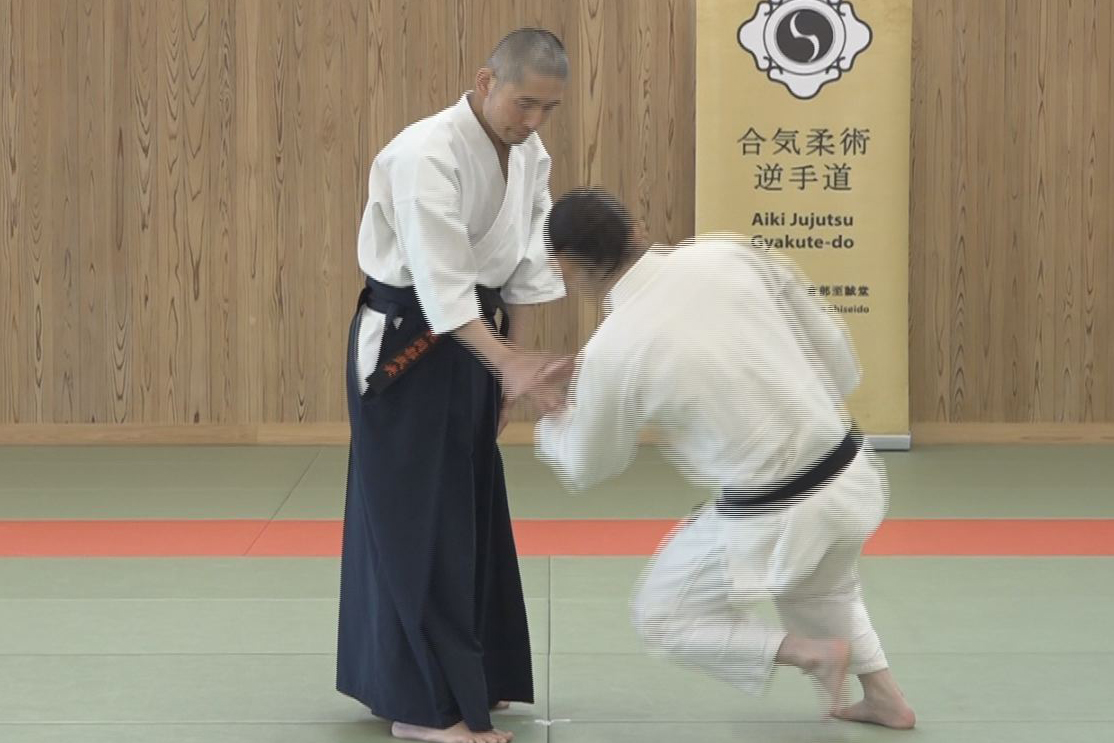
【AIKI Web Course Part 2】Lesson 12 – Gyaku-te by not Using Force nor AIKI
-
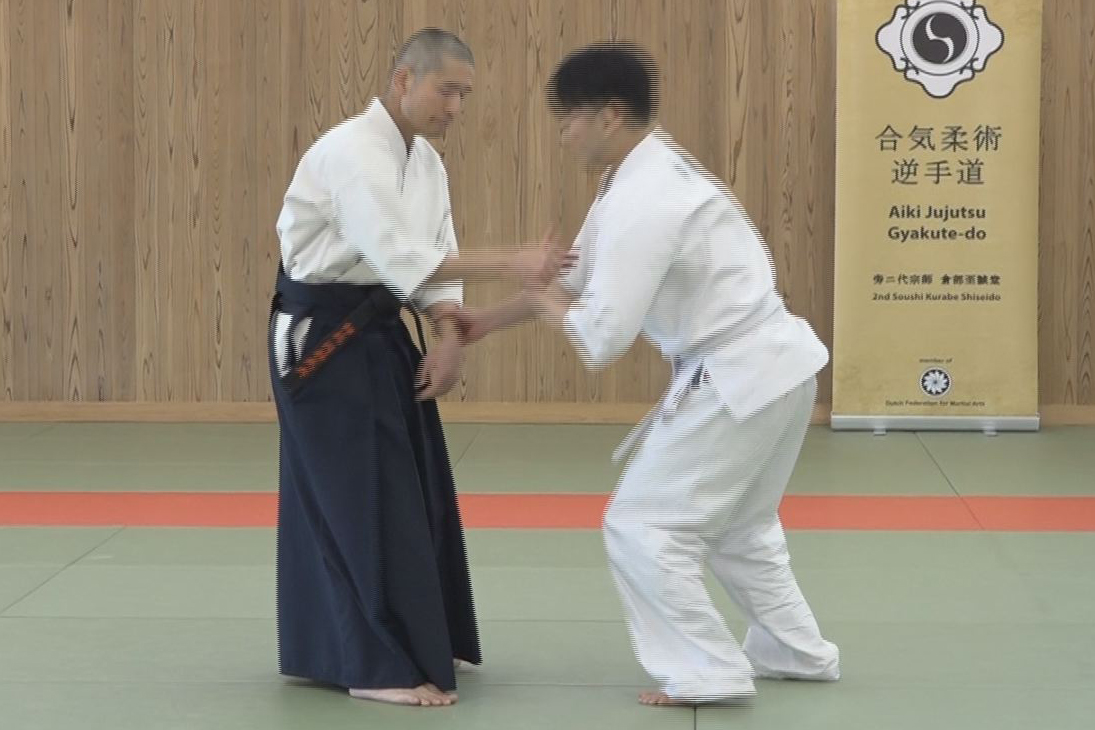
【AIKI Web Course Part 2】Lesson 11 – Gyaku-te Realized by the AIKI Method
-
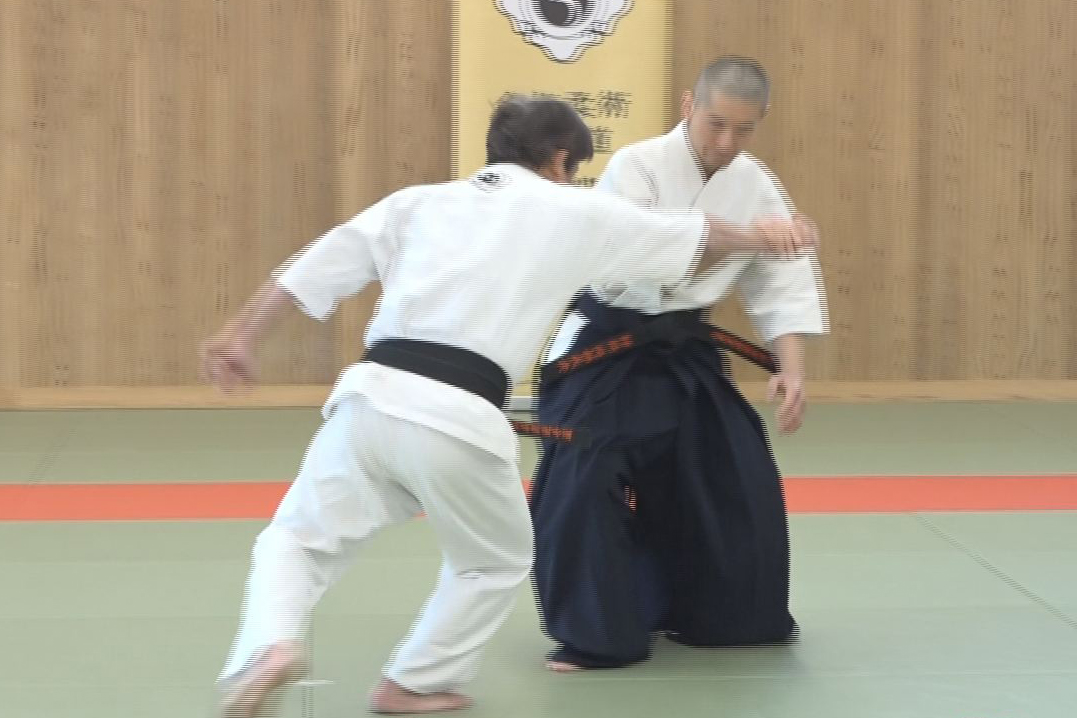
【AIKI Web Course Part 2】Lesson 10 – Application of Force Equilibrium method
-
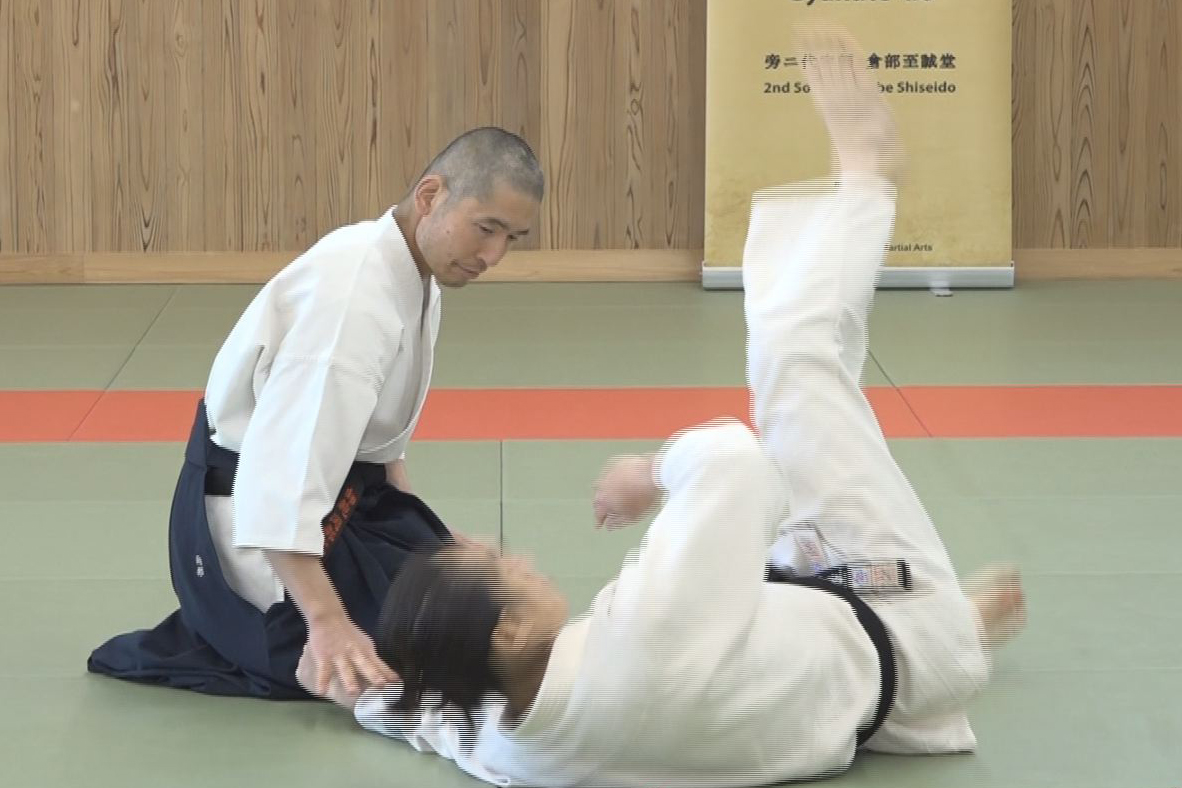
【AIKI Web Course Part 2】Lesson 9 – Force Equilibrium
-
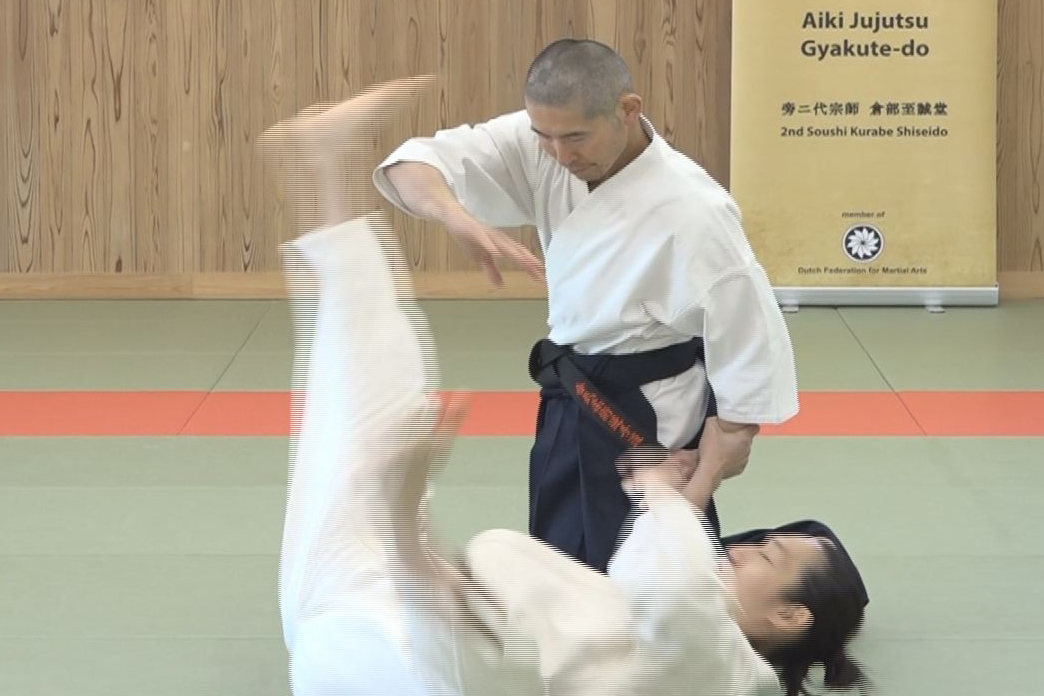
【AIKI Web Course Part 2】Lesson 8 – Application of Targeted Force Transfer
-
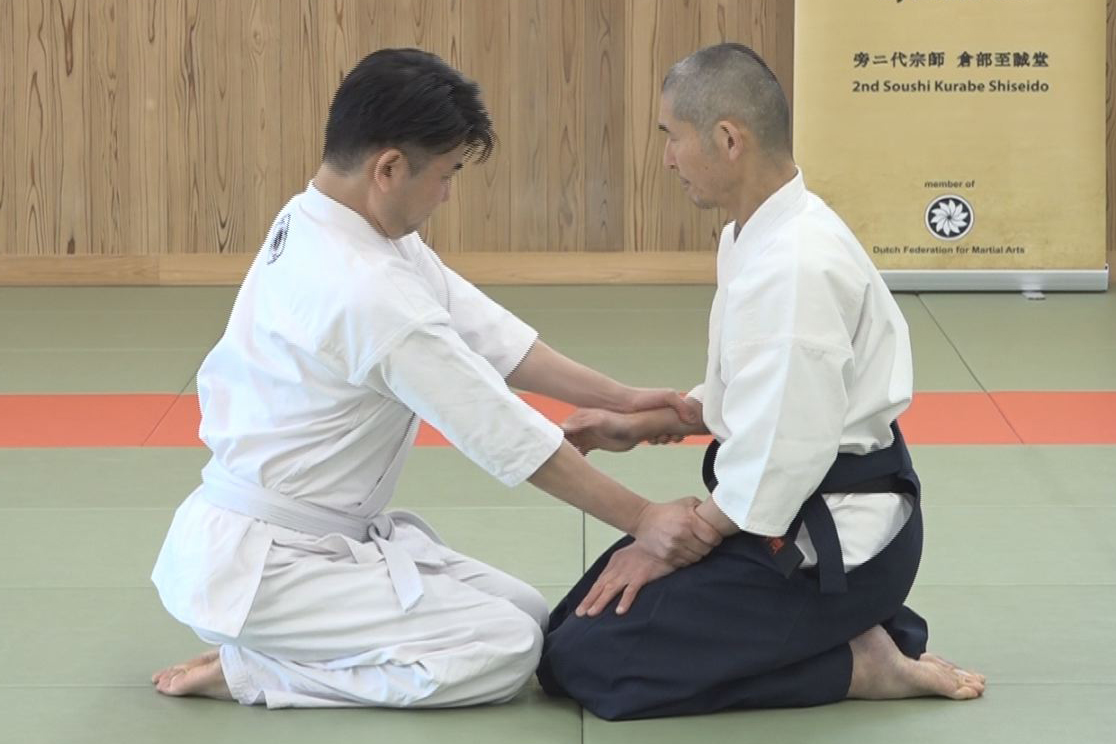
【AIKI Web Course Part 2】Lesson 7 – Targeted Force Transfer
-

【AIKI Web Course Part 2】Lesson 6 – Application of AIKI Connection
-
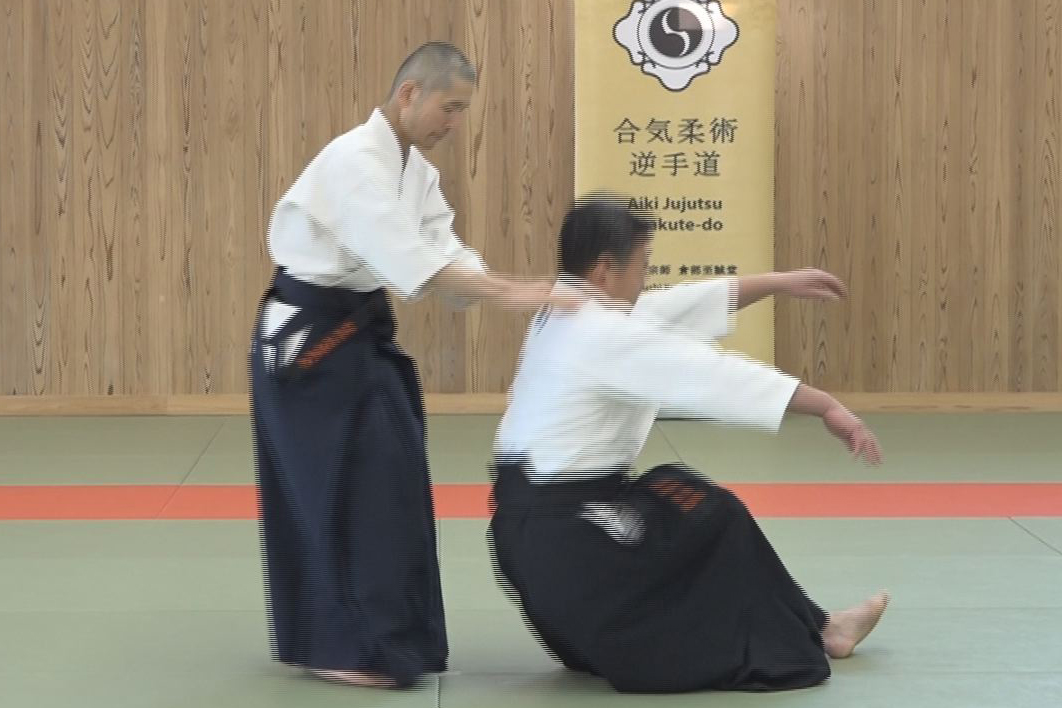
【AIKI Web Course Part 2】Lesson 5 – AIKI Connection
-

【AIKI Web Course Part 2】Lesson 4 – Application of Nondetectable Force Transfer
-
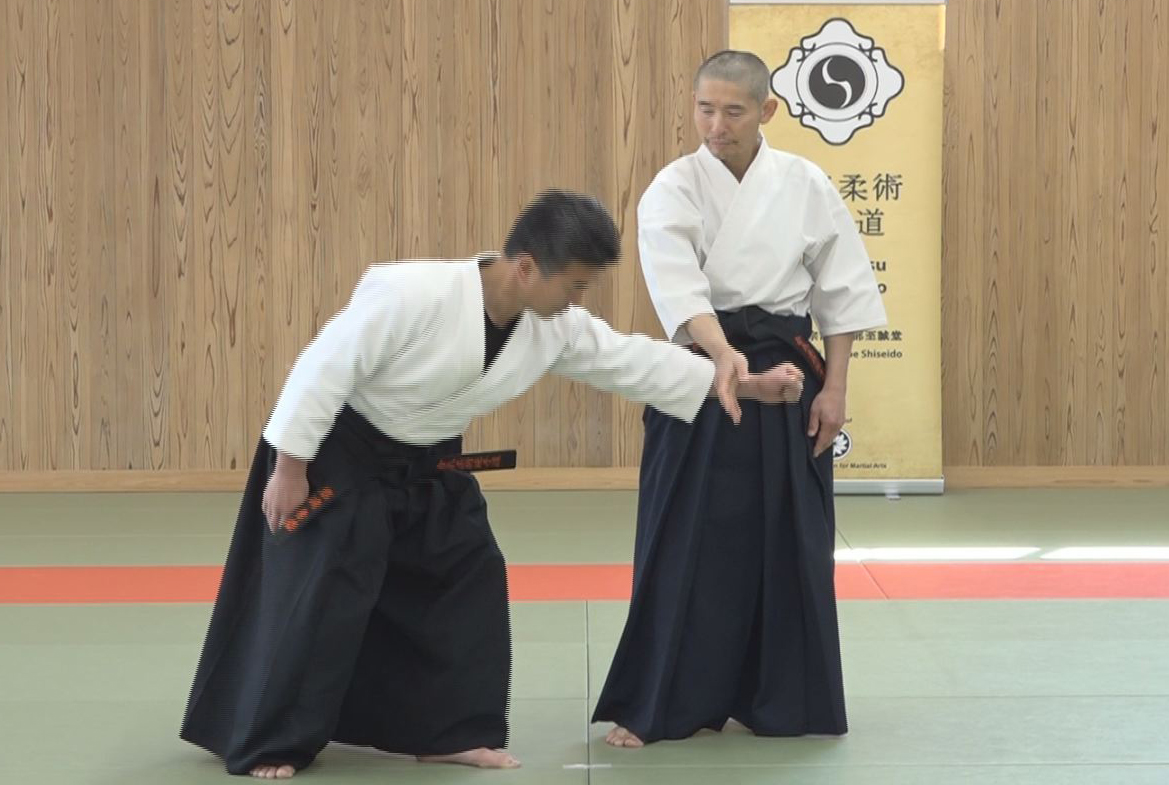
【AIKI Web Course Part 2】Lesson 3 – Explanation of Undetectable Force Transfer
-
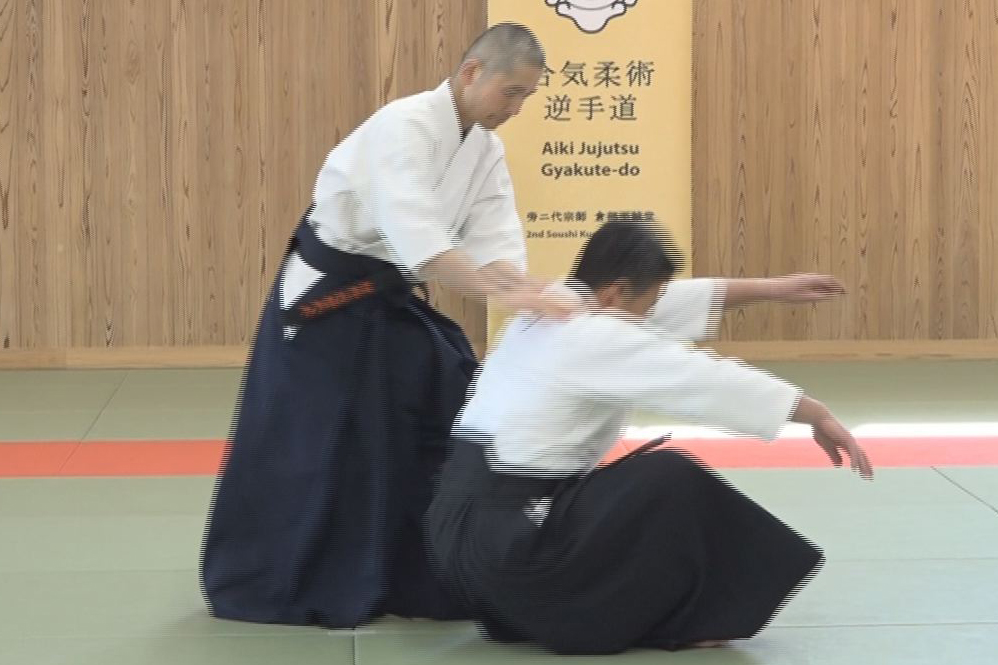
【AIKI Web Course Part 2】Lesson 2 – Application of Waving Method
-

【AIKI Web Course Part 2】Lesson 1 – The Explanation of Waving Method
-
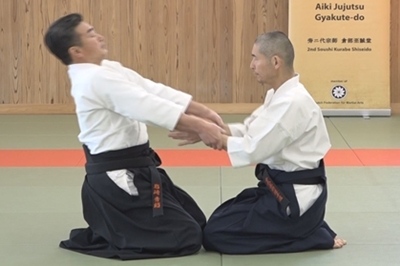
【AIKI Web Course Part 2】Introduction with video


